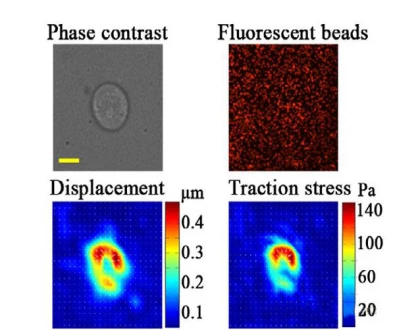The study found that the characteristics and mechanism of traction in immune synapses during B lymphocyte activation

The study found that the characteristics and mechanism of traction in immune synapses during B lymphocyte activation

Copyright © iCell Bioscience Inc, Shanghai 2018-2019
On August 8th, 2018, Liu Wanli Research Group of Tsinghua University School of Life published a research paper entitled "The Origin, Dynamic Characteristics and Function of Traction in the Process of B Lymphocyte Activation" published in the journal Science Signaling, and reported B lymphocytes. The detailed characteristics and related mechanisms of traction in the immune synapse during cell activation.

B lymphocytes serve as important participants in the immune response process of antibodies and maintain human health. The immune activation process of B cells is initiated after the B cell receptor (BCR) on the cell surface recognizes the foreign pathogen antigen. Previous work has revealed that B cells are exposed to the antigen displayed on the surface of antigen-presenting cells (APC), and during the process of immune activation, a significant spreading-contraction phenomenon occurs, thereby concentrating the antigen in the center of the contact surface between B cells and APC. A high-level immune synaptic structure is formed, and this spreading-contraction process is caused by the traction generated by B cells. However, the specific characteristics and mechanism of traction are not clear.
Based on the characteristics of B cells, this study improved the traditional traction microscopy technique, combined with the confocal live cell imaging system, to explore the temporal and spatial dynamic characteristics of B cells, and to regulate molecular mechanisms, and to explore patients based on rheumatoid arthritis. The difference in peripheral blood B cell traction between healthy controls and the healthy controls provides insight into the diagnosis or treatment of autoimmune diseases.
The study found that B cells produce 10-20nN centripetal traction during the spreading-contraction (activation) process on the surface of the elastic matrix that simulates APC stiffness in vivo. The traction force is rapidly generated within 5 min of activation, and its strong region is distributed in cells and matrix. This feature can be maintained for up to 30 minutes on the periphery of the contact surface.
The repulsive forces provided by actin recombination, myosin and dynein provide the driving force for traction. Screening and replenishment experiments using knockout cell line libraries have demonstrated that some signaling molecules in the membrane proximal BCR signaling pathway play an important role in the production and maintenance of traction. Molecularly, the degree of aggregation (fluorescence intensity) of local BCR microclusters is positively correlated with the intensity of traction. The IgG B cells after class conversion produced greater traction than the original IgM B cells, and this difference was related to the intracellular region sequence of the membrane immunoglobulin mIg heavy chain.
Finally, the study found that peripheral blood B cells in patients with rheumatoid arthritis produce greater traction, which may be related to the abnormal activation of their own antigens. This study quantitatively characterized traction, an important indicator of the activation process of B lymphocytes, and systematically explored the regulation and influence mechanisms related to the production and maintenance of traction, and also provided research on immune activation and immune regulation of B lymphocytes. The new research ideas provide a new theoretical basis for further understanding of autoimmune diseases, and thus exploring its pathogenesis and development of drugs or vaccines.
 Loading ....
Loading ....
